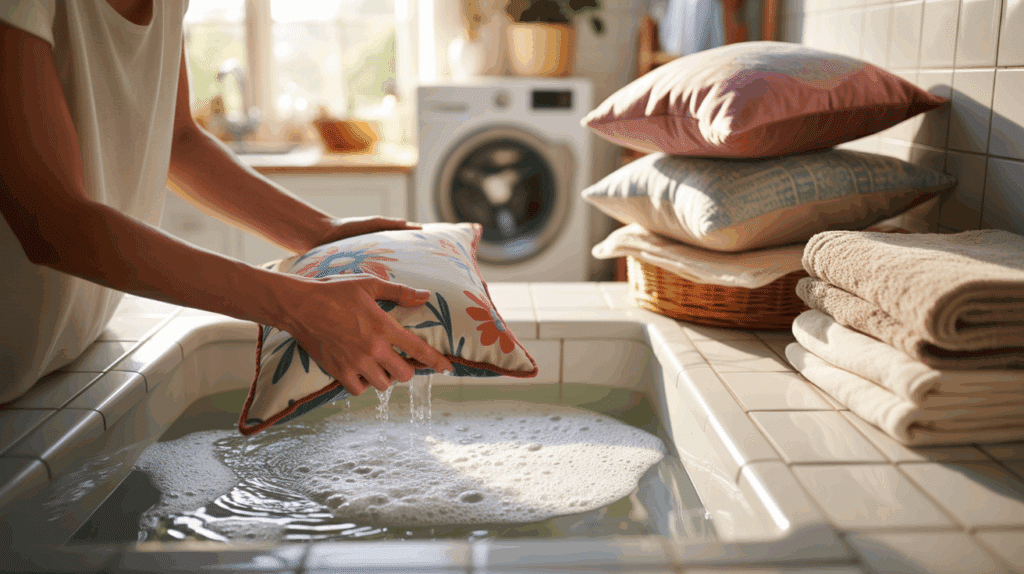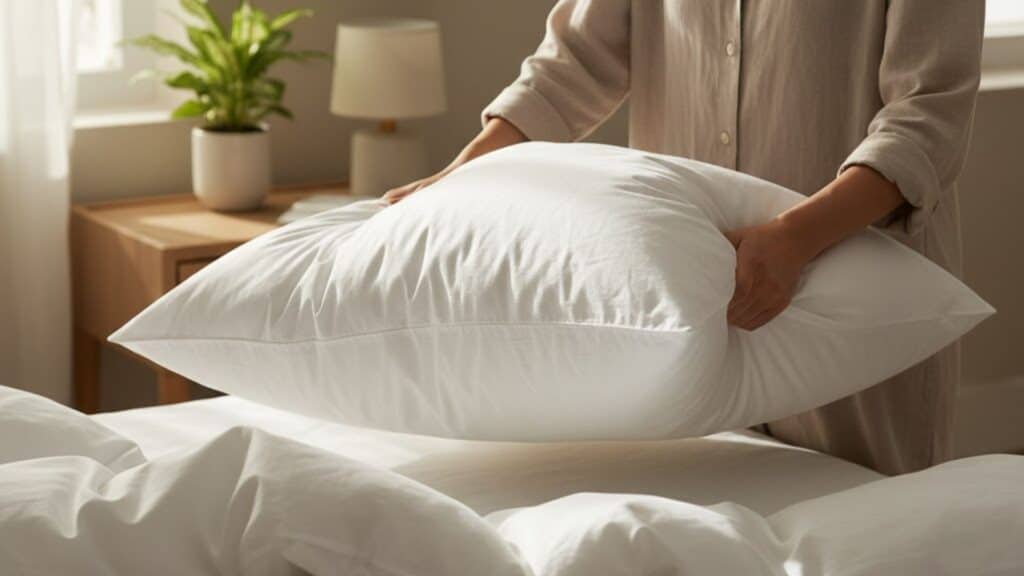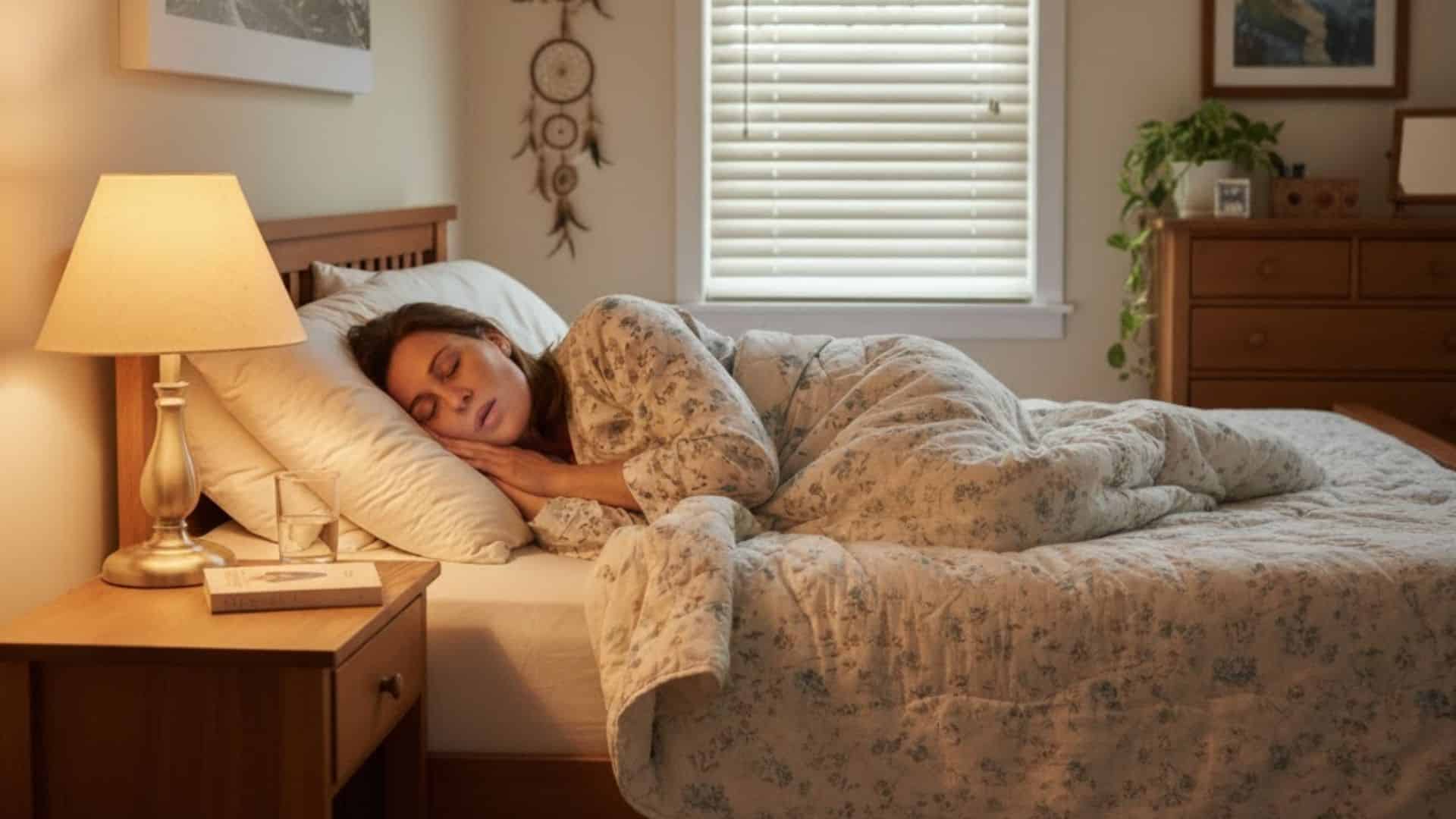Throw pillows make your home feel warm and inviting, but over time, they pick up dust, oils, and odors that need attention.
If you’ve ever wondered how to wash throw pillows without ruining their shape, this guide is for you.
I’ll walk you through easy, practical methods to keep your pillows clean and fresh, even when the covers don’t come off.
You’ll learn when to wash them, which cleaning method to choose, and how to dry them safely so they stay fluffy and bright. With a little care, you can make every pillow in your home feel like new again.
How Often to Clean Throw Pillows
Keeping a regular cleaning schedule helps your throw pillows stay soft, fresh, and long-lasting. Use this guide to decide how often to clean based on use and household needs.
| Type of Use | How Often to Clean | Cleaning Method | Extra Tips |
|---|---|---|---|
| Light-use pillows | Once a month | Surface clean; vacuum or lint-roll | Air them out in sunlight for 1–2 hours |
| Daily-use pillows | Every 3–6 months | Deep clean; wash removable covers monthly | Helps remove oils, sweat, and dirt |
| Allergy or pet homes | Every 1–2 months | Gentle wash or deep clean | Reduces dander, pollen, and dust mites |
| Seasonal refresh | Twice a year | Full wash | Maintains shape, color, and freshness |
Sticking to this schedule keeps your pillows in good condition and helps prevent dust buildup, odors, and early wear.
How to Wash Throw Pillows: Different Methods
Before cleaning, take a moment to understand what kind of pillow you’re dealing with. Each fabric reacts differently to water and detergent.
Some can handle gentle washing, while others should only be spot cleaned. By choosing the right method, you can keep your pillows clean and in good condition.
Check the Care Label and Pillow Type First
Always start by reading the care label. It tells you whether the pillow should be spot cleaned, hand-washed, or machine-washed. Ignoring this step can cause damage or shrinkage.
Next, identify the type of filling:
- Polyester: Safe for gentle washing; dries quickly.
- Down or feather: Can be washed, but must be dried fully to prevent clumping.
- Foam or microbead: Never soak these; clean the surface only.
Check the outer material too. Fabrics like silk, velvet, or heavily embroidered covers often need professional cleaning or very gentle spot treatment.
Gather Your Cleaning Supplies
Before you begin, gather everything you’ll need to make cleaning easier:
- Mild liquid detergent
- Soft brush and white cloths
- Vacuum with upholstery attachment
- Mesh laundry bag
- Dryer balls or clean tennis balls
- Large towels for pressing and drying
1. Spot Cleaning Method (for “Spot Clean Only” Labels)
If your pillow says “spot clean only,” avoid soaking it. Surface cleaning keeps the fabric and filling safe while removing dirt and stains. Here’s how to do it right.
Step 1: Test a hidden spot with a damp white cloth. If color transfers, clean with plain water only.
Step 2: Mix cool water with a few drops of mild detergent in a small bowl.
Step 3: Dip a soft cloth or brush into the solution and gently scrub the stain from the outside in.
Step 4: Wipe with a clean, damp cloth to remove soap residue.
Step 5: Press the spot with a towel to absorb moisture, then air dry completely away from sunlight.
Once dry, fluff the pillow to bring back its shape. This quick process removes stains safely without damaging the fabric or filling.
2. Machine Wash Method (If the Label Allows It)
If your pillow’s label allows machine washing, this method saves time while still keeping the filling and fabric safe. Follow these quick steps to wash them properly.
Step 1: Choose a gentle or delicate cycle with cold or lukewarm water and a small amount of detergent. Avoid bleach and fabric softeners.
Step 2: Wash two pillows at a time to keep the load balanced. If they have embroidery or delicate seams, place each one in a mesh laundry bag.
Step 3: Tumble dry on low heat with dryer balls or clean tennis balls to prevent clumping and keep the filling even.
Step 4: Pause halfway to fluff the pillows by hand, then continue drying until no moisture remains.
Once finished, your pillows should feel clean, soft, and evenly shaped; ready to use again without any lumps or damp spots.
3. Hand Wash Method (Best for Delicate or Uncertain Pillows)
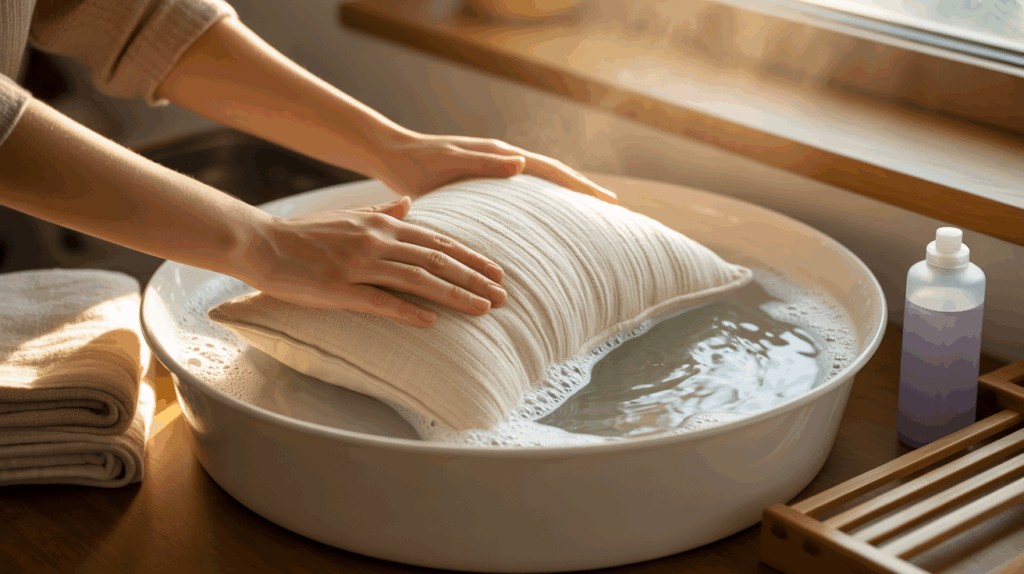
If you’re unsure about machine washing, hand washing is the safest way to clean your pillows without risking damage. It gives you more control and works well for delicate fabrics or light fillings.
Step 1: Fill a basin with lukewarm water and add a few drops of mild detergent. Submerge the pillow and gently move it around to loosen dirt. Avoid twisting or squeezing.
Step 2: Drain the soapy water and refill with clean water. Press the pillow gently to rinse out all the detergent until the water runs clear.
Step 3: Lay the pillow between two towels and press to absorb moisture. Place it on a flat drying rack with good airflow and turn it occasionally to help it dry evenly.
Cleaning your throw pillows this way keeps them soft, fresh, and properly shaped. Always let them dry completely before use to avoid trapped moisture or mildew.
Tips for Different Pillow Materials
Not all throw pillows can be cleaned the same way. The right method depends on the material and filling.
Using the wrong approach can cause color loss, clumping, or damage to the fabric. Use the table below as a quick guide to clean each pillow type safely.
| Material | Cleaning Method | Drying Tips | Extra Care Notes |
|---|---|---|---|
| Polyester | Hand wash or gentle machine cycle using mild detergent and cold water | Tumble dry on low heat with dryer balls | Dries fast and holds its shape well |
| Down or Feather | Gentle machine wash in cool or warm water with mild detergent | Dry on low heat; pause halfway to fluff and prevent clumps | Avoid fabric softeners; ensure it’s completely dry inside |
| Foam or Microbead | Surface clean only with a damp cloth and mild soap | Air dry in a ventilated area away from heat | Never soak; water can damage the structure or cause mold |
| Velvet or Silk | Spot clean with a soft cloth and mild detergent | Air dry naturally, away from sunlight | Test for color transfer; use professional cleaning for tough stains |
By matching your cleaning method to the pillow’s material, you’ll protect its shape, prevent damage, and keep it looking clean and comfortable for years.
Drying and Fluffing Pillows Correctly
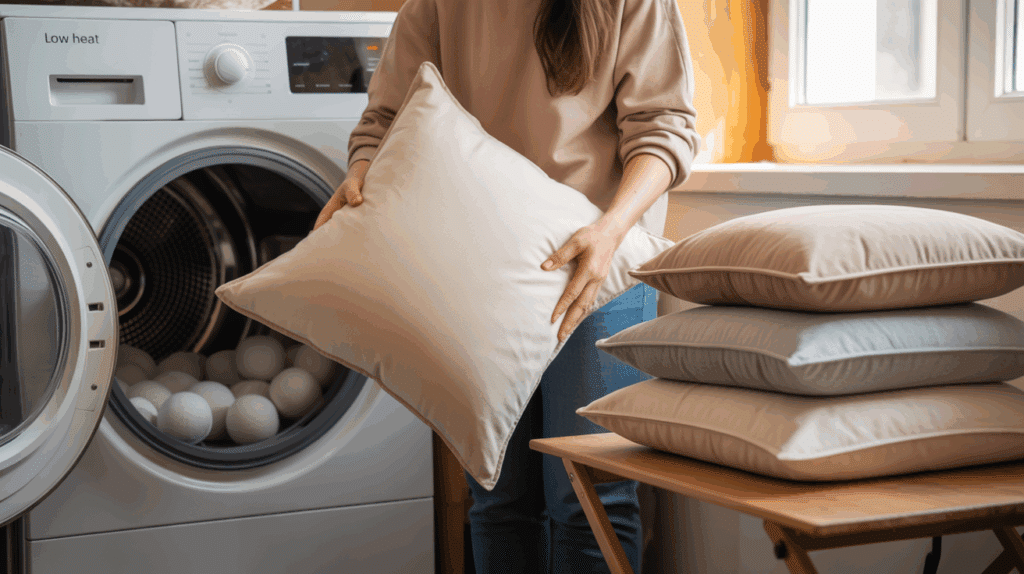
Proper drying keeps pillows soft, clean, and evenly shaped. When moisture gets trapped inside, it can lead to mildew, odors, or uneven filling.
Always dry on a low or delicate heat setting to protect the fabric and prevent shrinkage. Toss in a few dryer balls or clean tennis balls to keep the filling loose and clump-free.
Pause the cycle occasionally to fluff the pillows by hand, then continue drying until the center feels completely dry.
Afterward, let them air out for a few hours before using. This gentle process helps your pillows stay fresh, fluffy, and comfortable for longer.
Common Mistakes to Avoid
Even with the right cleaning method, a few simple missteps can damage your throw pillows or shorten their lifespan. Keep these common mistakes in mind when washing or drying.
- Ignoring the care label: Skipping this step can lead to shrinking, fading, or ruined fabric.
- Using too much detergent: Extra soap leaves residue that attracts dust and dulls the fabric.
- Washing foam or microbead pillows in water: These fillings can break down or grow mold if soaked.
- Drying on high heat: Excessive heat weakens seams and hardens fillings.
- Putting damp pillows back on furniture: Moisture left inside can cause mildew or a musty smell.
Avoiding these mistakes helps your pillows stay clean, soft, and long-lasting.
When It’s Time to Repair or Replace Your Pillows
Even with regular cleaning, throw pillows won’t last forever. Over time, fabrics fade, fillings lose shape, and odors can become harder to remove.
If you’re unsure whether it’s time for a change, a few signs can help you decide.
Quick signs to look for:
- Musty smell
- Lumpy or flat filling
- Torn seams or loose fabric
- Discoloration or mold spots
If a pillow looks worn, feels uneven, or no longer smells fresh, replacing it keeps your space cleaner, more comfortable, and better looking.
Final Thoughts
Learning how to wash throw pillows the right way keeps your home cleaner, fresher, and more comfortable.
You’ve seen how small habits, like reading the care label, drying on low heat, and using gentle cleaners, can make a big difference in keeping your pillows in great shape.
I like to think of this as a simple home-care task that pays off fast. Clean pillows don’t just look better, they feel better, too. Now that you know how to handle every type, you can keep yours fresh without any guesswork or stress.
If you found these tips useful, take a look at more of my cleaning and home care guides for easy, practical ways to keep your space feeling its best.


